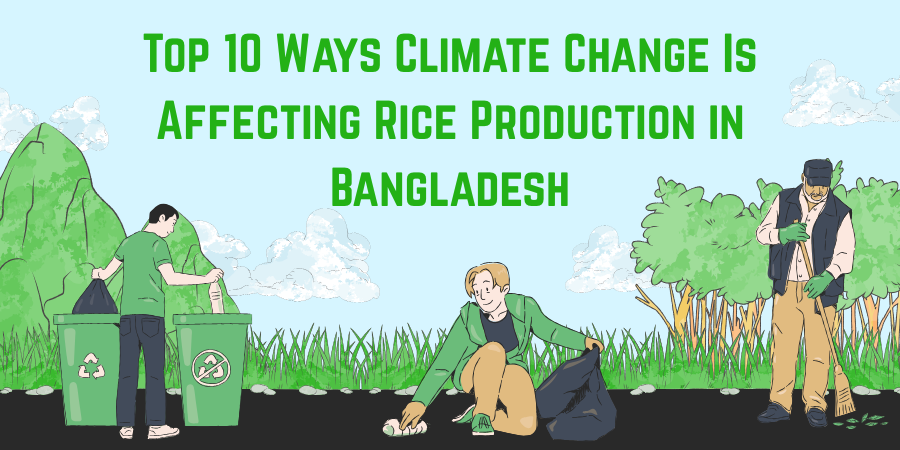Top 10 Ways Climate Change in Bangladesh Affects Rice Production
BY
Mitu
Bangladesh is among the most climate-vulnerable countries in the world, and our staple food—rice—is under increasing threat. Over 70% of our farmers rely on rice cultivation, making the impact of climate change in Bangladesh deeply personal and widespread. From rising temperatures to shifting rainfall patterns, climate change is disrupting rice farming in serious ways. Below, we explore the top 10 effects of climate change on rice production in Bangladesh and what can be done to protect our food future. 1. High Temperature Reduces Rice Yield When the temperature exceeds 35°C during rice flowering stages, grain setting suffers. A 1°C rise can reduce yields by up to 10%. This problem is severe in Rajshahi and Rangpur during summer. 2. Erratic Rainfall Disrupts Farming Seasons Traditional monsoon patterns are no longer reliable. Farmers struggle to plan sowing and harvesting for Aus, Aman, and Boro seasons, often facing droughts during planting and floods at harvest. 3. Flooding Destroys Crops and Infrastructure More frequent and intense floods—especially in haor regions—wash away ripened rice fields. Floods also damage seedbeds, irrigation systems, and roads, affecting the whole farming ecosystem. 4. Cyclones and Storm Surges Devastate Coastal Rice Farming Cyclones like Sidr, Aila, and Amphan not only flatten rice fields but also salinise coastal soils, making them infertile for years. Satkhira, Khulna, and Patuakhali farmers suffer the most. 5. Rising Soil Salinity in Coastal Areas Sea level rise and storm surges allow saltwater intrusion into farmlands. High salinity reduces rice productivity and forces farmers to abandon fields, especially in coastal belts. 6. Drought Slows Growth and Lowers Yield Regions like Dinajpur and Rangpur face prolonged dry spells and water shortages. Drought hampers sowing and stunts crop growth, especially affecting Boro rice dependent on irrigation. 7. Pests and Diseases Are Increasing Warming and humid conditions lead to more frequent pest attacks, like stem borers and leaf hoppers, and diseases such as rice blast. This raises costs, pesticide use, and environmental risks. 8. Soil Erosion and Depletion Harm Productivity Floods erode topsoil, while droughts weaken soil structure. Poor soil fertility means farmers rely more on chemical fertilisers, increasing costs and long-term land degradation. 9. Traditional Rice Varieties Are Disappearing Beloved local rice types are failing to survive heat, salinity, and erratic weather. This loss of biodiversity limits farmers' options and weakens cultural food traditions. 10. Farmers Are Turning to Climate-Resilient Solutions The Bangladesh Rice Research Institute (BRRI) has introduced stress-tolerant varieties like BRRI dhan47, 67, and 74. However, many farmers lack the resources or training to adopt them. Final Thoughts Climate change in Bangladesh and rice production are now tightly linked. From Barisal to Rangpur, farmers are under pressure. Urgent steps must be taken to: Promote climate-smart agriculture Invest in disaster-resistant infrastructure Support access to climate-resilient seeds Provide training and technology to farmers Act now—before our future food security is lost. FAQ Q1: How is climate change affecting agriculture in Bangladesh? Q2: What are the major factors affecting rice production? Q3: What’s the current trend in rice production? Q4: Which crops are most affected by climate change? Q5: Is Bangladesh self-sufficient in rice? Q6: What are the main rice growing seasons? You can read also: https://bangladeshranking.com/post/Top_10_Eco-Friendly_Brands_in_Bangladesh/103
A: Unpredictable rainfall, floods, rising temperatures, and salinity reduce yields and disrupt planting seasons, especially for small-scale rice farmers.
A: Key factors include climate (rainfall and temperature), soil quality, irrigation, pest outbreaks, and access to improved seeds and farming methods.
A: While total production has increased, climate change is making yields more unpredictable, especially in flood- and cyclone-prone areas.
A: Rice, wheat, potatoes, vegetables, and jute are especially vulnerable to temperature swings, drought, and extreme weather.
A: Bangladesh is mostly self-sufficient, but climate disruptions threaten this status and increase production costs.
A: The three seasons are Aus (March–August), Aman (July–December), and Boro (November–May), each with unique climate challenges.

POST A COMMENT
OTHER POSTS OF AMAZING BANGLADESH CATEGORY







To comment in this Blog, SignIn with Google